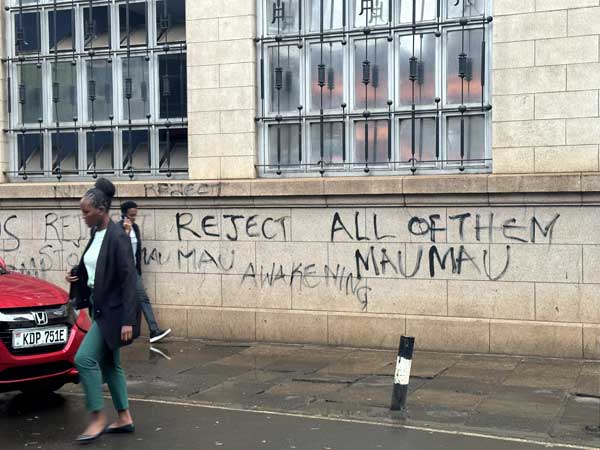Kenya's tax protests causes clashes in Nairobi and across the country

[Writing on the walls of Nairobi happened during the protest. Photo Credit to Erin Cho]
This week, thousands of Kenyans took to the streets across the country to protest against the recently proposed Finance Bill and tax increases introduced by President Wiliam Ruto’s administration.
The Finance Bill, which includes various new taxes and increases on existing ones, has sparked outrage among Kenyans already grappling with economic hardship.
The most contentious measures include a higher Value-Added Tax (VAT) on essential goods, increased fuel levies, and a new housing tax.
Critics and demonstrators argue that these new policies negatively affect poor and middle-class citizens.
The tax on petroleum products has been doubled from 8% to 16%, leading to a ripple effect on the prices of goods and services.
Furthermore, people earning over 500,000 shillings ($3,500) will now pay 32.5% in tax, and those earning above 800,000 shillings will pay 35%, which amounts to about 40% of their income when combined with the new housing tax (1.5%) and medical insurance tax (2.5%).
Meanwhile, President Ruto has defended the bill as necessary for economic stability and growth, arguing that the revenue generated will fund critical infrastructure projects and social services.
The tax rises are mainly intended to pay Kenya’s large debts.
However, many Kenyans, given their daily struggles, see these measures as ill-timed and ineffective and argue that the government should first cut spending.
Various civil society groups, labor unions, and opposition parties organized the protests to demonstrate their opposition.
From the bustling streets of Nairobi to rural towns, demonstrators expressed their discontent through marches, sit-ins, and public speeches.
In Nairobi, protestors gathered at Uhuru Park and marched towards the Parliament buildings, holding placards and chanting slogans against the Finance Bill.
“No to higher taxes!” and “Ruto, listen to the people!” were among the common refrains.
Similar scenes played out in cities like Mombasa, Kisumu, and Eldoret.
The government’s response to the protests has been mixed.
In a televised address, President Ruto urged Kenyans to remain calm, stating, “We hear your concerns, and we are committed to finding a balance that will ensure both economic growth and the well-being of our citizens.”
Despite Ruto’s recent concession, anti-government protestors have demanded President Ruto to resign.
While President Ruto has called for dialogue and understanding, security and police forces have been deployed to manage the crowds, leading to clashes in some areas.
The demonstrations have seen a heavy-handed response from security forces, with widespread reports of police violence.
Protestors have been met with tear gas, water cannons, and rubber bullets.
In several instances, live ammunition has been used, resulting in injuries and fatalities among the demonstrators.
Eyewitnesses have reported numerous incidents of brutality, including beatings and arbitrary arrests, further inflaming public anger.
According to the Kenya Medical Association, police forces have killed at least 13 people by firing at protestors.
Apart from the death of the demonstrators, private businesses in the cities where the protests took place have also been affected.
In demonstrations against the tax increase, protestors started to raid grocery stores, restaurants, and coffee shops, causing dozens of injuries to innocent people and harming business owners.
Despite the violent protests subsiding, anger towards the government remains high, and more demonstrations are planned for the upcoming weeks.

- Erin Cho / Grade 11
- Lake Forest Academy

![THE HERALD STUDENT REPORTERS [US]](/assets/images/logo_student_us.png)
![THE HERALD STUDENT REPORTERS [Canada]](/assets/images/logo_student_ca.png)
